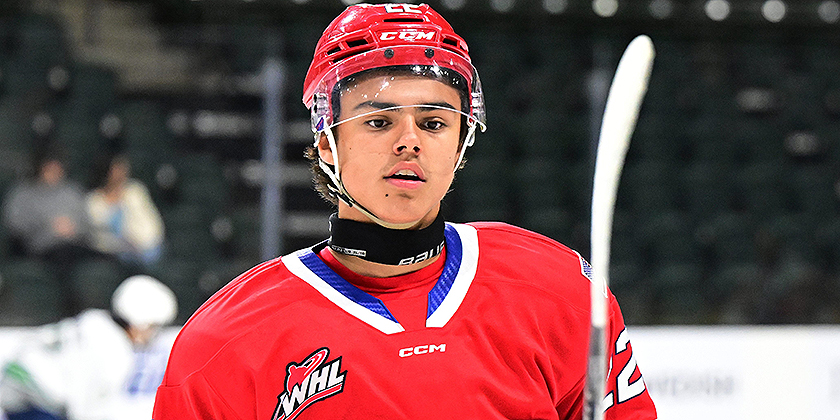
Hayden Paupanekis (C, R, 6’4″, 200, Kelowna Rockets, 12/14/2007)
Hayden Paupanekis is a prototypical power forward with a large frame and physical presence that makes him an intriguing prospect for the NHL. At 6’4″ and 200 pounds, he has the size, mobility, and tools to impact all three zones. However, his game remains a work in progress, with key areas such as puck management, 200′ assertiveness, and physical engagement requiring improvement and consistency. With continued development, Paupanekis has the potential to evolve into a reliable middle-six NHL center capable of contributing on both ends of the ice.
Strengths
Size and Physical Presence:
At 6’4″, Paupanekis uses his size effectively to protect the puck and drive the net.
He shows willingness to engage physically, delivering one hard hit per game and battling for position at the net front.
Mobility and Skating:
Surprisingly agile for a player of his size, Paupanekis generates deceptive speed, allowing him to gain steps on defenders during the rush and on the forecheck.
His mobility complements his role as a physical, puck-protecting forward.
Hockey IQ and Defensive Awareness:
Displays an understanding of defensive zone responsibilities, including switches while defending the cycle or scissor plays and filling gaps in coverage during breakdowns without abandoning his responsibilities.
Effective at reading plays and forcing turnovers, averaging 4 takeaways per game.
Net-Front Play:
Combines size and strength to establish position in high-danger areas. and has begun to use a push-off to create separation from his defender.
Generates 1.67 grade “A” scoring opportunities per game, showing a nose for the net and the ability to create offense through effort.
Potential Upside:
Shows flashes of offensive creativity, with good hands in tight and the ability to make plays under pressure.
Willing to compete and improve, suggesting a strong work ethic and commitment to his development.
Areas for Improvement
Face-Off Performance:
Currently wins 52% of his face-offs, but this must improve for him to excel as a center at higher levels.
Gaining strength and improving technique will be crucial for his development as a 200′ center who can be trusted during important defensive situations.
Puck Management and Passing:
Completes 84% of his passes, but a tendency to force plays leads to turnovers (4 giveaways per game).
Needs to improve his decision-making under pressure to avoid unnecessary mistakes.
Offensive Assertiveness:
Averages only 3 shot attempts and 1.74 shots on goal per game, which is too low given his size and potential as a net-front presence.
Needs to attack scoring areas more consistently and generate more grade “A” scoring opportunities for himself (scores on just 14% of grade “A” chances).
Physical Engagement and Battle Wins:
Wins 49% of his 50/50 puck battles, a number that should increase as he develops strength and explosiveness.
While he delivers hits, he needs to add more intimidation and consistently dominate physically in board battles and in the slot.
Penalty Drawing:
Draws only 0.25 penalties per game, a figure that should improve as he uses his size and physicality to challenge opponents more effectively.
Skating Posture:
Currently has an upright skating posture, which limits his explosiveness. Gaining strength will create a lower stance will help him generate more power in his stride.
Key Development Goals
Improve Face-Off Technique: Focus on timing, strength, and positioning to increase win percentage to be a reliable option for defensive zone face-offs.
Increase Physical Domination: Leverage size more effectively to intimidate opponents and win puck battles, particularly in high-traffic areas.
Enhance Offensive Assertiveness: Take more shots and drive the net more consistently to maximize size to generate high percentage scoring opportunities.
Refine Puck Management: Prioritize smart, high-percentage plays below the tops of the circles in the offensive zone to reduce giveaways and maintain possession.
Develop Skating Mechanics: Lower skating posture to improve explosiveness and balance, enhancing both offensive and defensive transitions.
Special Teams Impact: Build on current power play usage to become a dual-threat on special teams, with added focus on penalty killing.
Projection
Paupanekis projects as a middle-six NHL center with the ability to play a power-forward style of game. His size and physicality make him an attractive prospect with valuable NHL upside. With improvement in his offensive assertiveness, puck management, and face-off skills, he could become a valuable asset on all three zones and in all three phases of the game.
Draft Outlook
We currently have Paupanekis rated as an early-to-mid second-round selection in the 2025 NHL Draft. His combination of size and tools will make him a compelling pick for teams willing to invest in his development.
Player Comparison
Nick Paul: While Paupanekis is not yet at Paul’s level, his blend of size, defensive responsibility, and high potential for improved physical play draws similarities. With further development, he could become a dependable two-way center in a similar mold.
Final Assessment
Hayden Paupanekis possesses the size, mobility, and potential to be a 200′ force in the NHL. While his game remains unpolished, his willingness to engage physically and compete, combined with his work ethic, suggests he will develop into a reliable two-way center with the right coaching and commitment. Teams investing in his development will likely reap significant rewards down the line.
Photo Credit: Dan Hickling/Hickling Images
